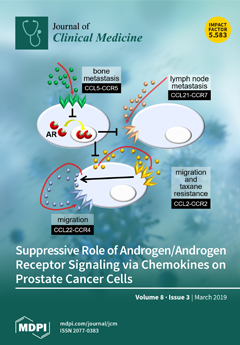The metabolites produced by the host’s gut microbiota have an important role in the maintenance of intestinal homeostasis, but can also act as toxins and induce DNA damage in colorectal epithelial cells increasing the colorectal cancer (CRC) chance. In this scenario, the impact
[...] Read more.
The metabolites produced by the host’s gut microbiota have an important role in the maintenance of intestinal homeostasis, but can also act as toxins and induce DNA damage in colorectal epithelial cells increasing the colorectal cancer (CRC) chance. In this scenario, the impact of some of the components of the natural human gastrointestinal microbiota, such as
Enterococcus faecalis (
E. faecalis), at the onset of CRC progression remains controversial. Since under dysbiotic conditions it could turn into a pathogen, the aim of this study was to compare the effect of
E. faecalis’ strains (isolated from CRC patients and healthy subjects’ stools) on the proliferation of different colorectal cells lines. First, we isolated and genotyping characterized the
Enterococcus faecalis’ strains. Then, we analyzed the proliferation index (by 3-(4,5-Dimethylthiazol-2-yl)-2,5-Diphenyltetrazolium Bromide (MTT) assay) of three tumor and one normal intestinal cell lines, previously exposed to
E. faecalis strains pre-cultured medium. Stool samples of CRC patients demonstrated a reduced frequency of
E. faecalis compared to healthy subjects. In addition, the secreted metabolites of
E. faecalis’ strains, isolated from healthy donors, decreased the human ileocecal adenocarcinoma cell line HCT-8 and human colon carcinoma cell line HCT-116 cell proliferation without effects on human colorectal adenocarcinoma cell line SW620 and on normal human diploid cell line CLR-1790. Notably, the metabolites of the strains isolated from CRC patients did not influence the cell growth of CRC cell lines. Our results demonstrated a new point of view in the investigation of
E. faecalis’ role in CRC development, which raises awareness of the importance of not only associating the presence/absence of a unique microorganism, but also in defining the specific characteristics of the different investigated strains.
Full article






